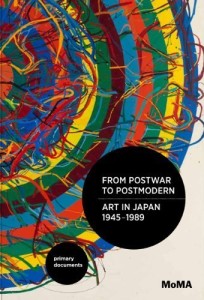JQ Magazine: Book Review – ‘From Postwar to Postmodern, Art in Japan 1945-1989: Primary Documents’

“What emerges from the multitude of ideas here is that art in Japan from this period is a visual record of repercussions that are still being felt today.” (Duke University Press)
By Jessica Sattell (Fukuoka-ken, 2007-08) for JQ magazine. Jessica is a freelance writer and a graduate student in arts journalism. She was previously the publicist for Japan-focused publishers Stone Bridge Press and Chin Music Press.
The abstract and avant-garde sculptor, painter and all-around revolutionary Japanese artist Tarō Okamoto famously said, “Art is an explostion” (geijutsu wa bakuhatsu da).
“Explosive” barely describes the energy and innovation in Japanese art in the latter half of the twentieth century. As From Postwar to Postmodern, Art in Japan 1945-1989: Primary Documents discusses, the decades between the end of World War II and the end of the Cold War marked an intensely fruitful period of groundbreaking creativity in Japan. The excitement, anxiety, and electricity that surged against the rigidity of old structures propelled Japanese art and artists into a much greater international conversation.
Published earlier this year by the Museum of Modern Art in New York and distributed by Duke University Press, this hefty tome accompanied the fall 2012-winter 2013 MoMA exhibition Tokyo 1955-1970: A New Avant Garde. There’s been a huge wave of both popular and scholarly interest in Japanese modern and contemporary art and dozens of high-profile shows at major North American museums and galleries, but the MoMA exhibit was the first to examine the “postwar” period that had been previously underrepresented. Part of this may be that the term “postwar” is tricky to define; the effects of WWII are undoubtedly still felt today and many argue that Japan is still “postwar.”
This book provides a solid foundation for an exploration of the issues and precedents leading up to the transformation of “postwar” art into the “postmodern” time. But, rather than simply rehash existing scholarship about Japanese history from 1945-1989, the book’s co-editors allow the artists, philosophers, critics and curators of this historical time to speak for themselves. The bulk of From Postwar to Postmodern includes a huge and multifaceted collection of primary source materials—personal essays, artist statements, interviews, magazine articles, interviews, critiques and manifestos—many of which have been translated into English for the very first time.
Primary documents are interspersed with brief critical essays to place the content within a greater historical context and inform their cultural significance. Overall, the selections here focus on “the critical avant-garde” and convey extremely complex themes of enthusiasm, apprehension and trauma over a broad range of artistic mediums including painting, sculpture, film, installation art, performance art, fashion, illustration, architecture and more. Chapters are arranged more or less by decade, beginning with Japanese artists looking to reestablish their personal and national identities after the annihilation of war and ending with Japan positioned as a dynamic global presence.
The biggest strength of From Postwar to Postmodern is its multidisciplinary approach that truly honors the diversity of themes present in this time period. Through this, it offers Japan (past and present) as a case study of an art world that broke free of international boundaries yet is still incredibly introspective. While the Japanese experience is obviously entirely unique, we see some archetypal conversations emerge through its postwar art: the legacies of cultural and political imperialism, anxiety, and searches for personal and collective senses of the self. There were so many other fascinating ideas that emerged from reading, including the concept of a global postwar shift of art from being a “national” practice to an “international” exchange and how Japanese artists looked to both domestic and foreign inspirations to contribute to “creative expression as a global conversation.”
From Postwar to Postmodern does a thoroughly solid job of attempting to make sense of a wildly diverse historical period that is still unfolding at hyper speed. This is an incredible resource for anyone serious about contemporary Japanese art and undertaking a study of the ideas, movements and manifestos that sprang from both city streets and private salons. The text is well-edited for this specialization but still very accessible for academics and general readers alike. Color plates are beautifully reproduced and the book’s design is clean, inviting and smartly arranged for quick reference.
This is also excellent as a general resource for learning more about the important milestones in contemporary Japanese culture as related to those in world art history. What emerges from the multitude of ideas here is that art in Japan from this period is a visual record of repercussions that are still being felt today.
For more JQ magazine book reviews, click here.


Comments are closed.